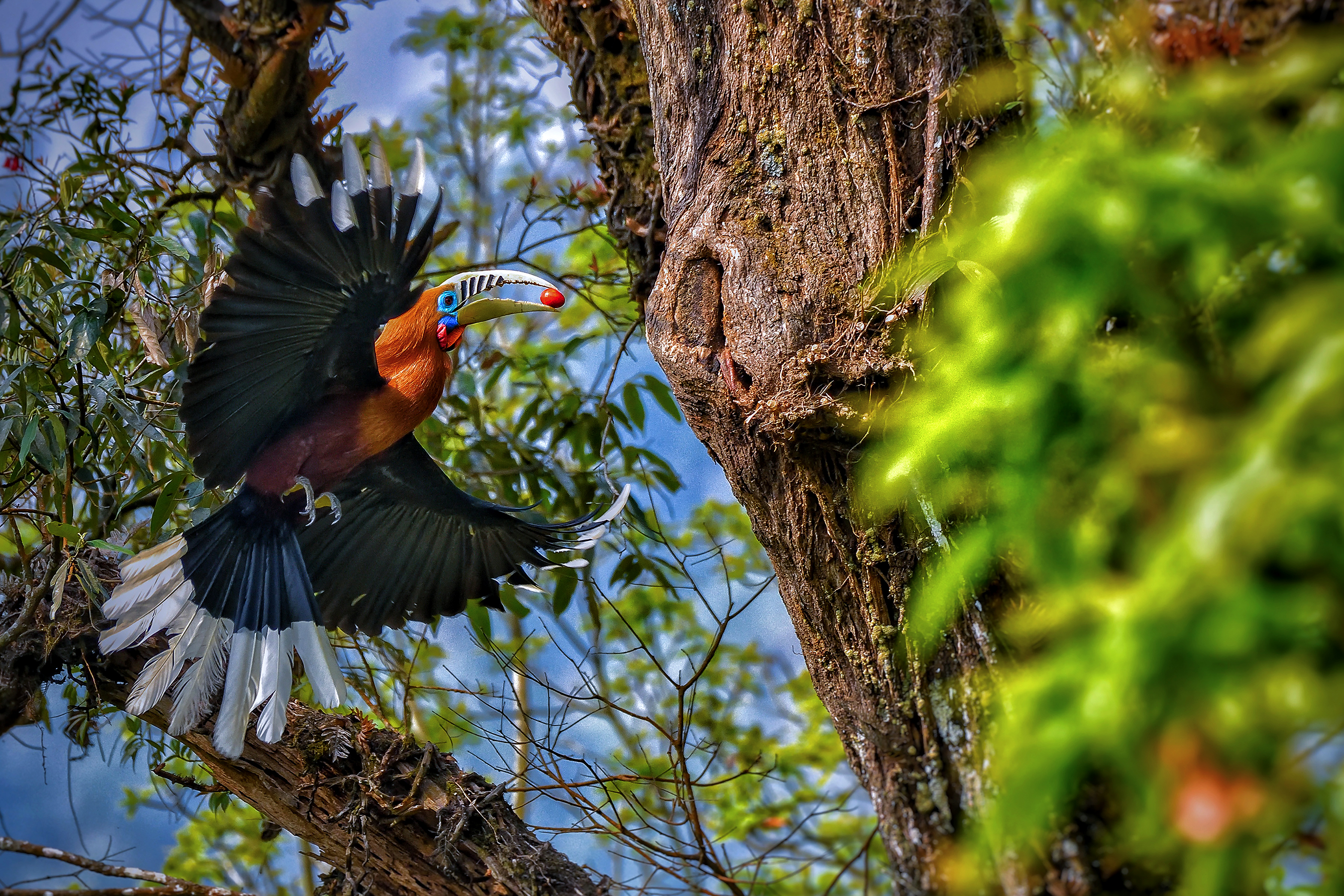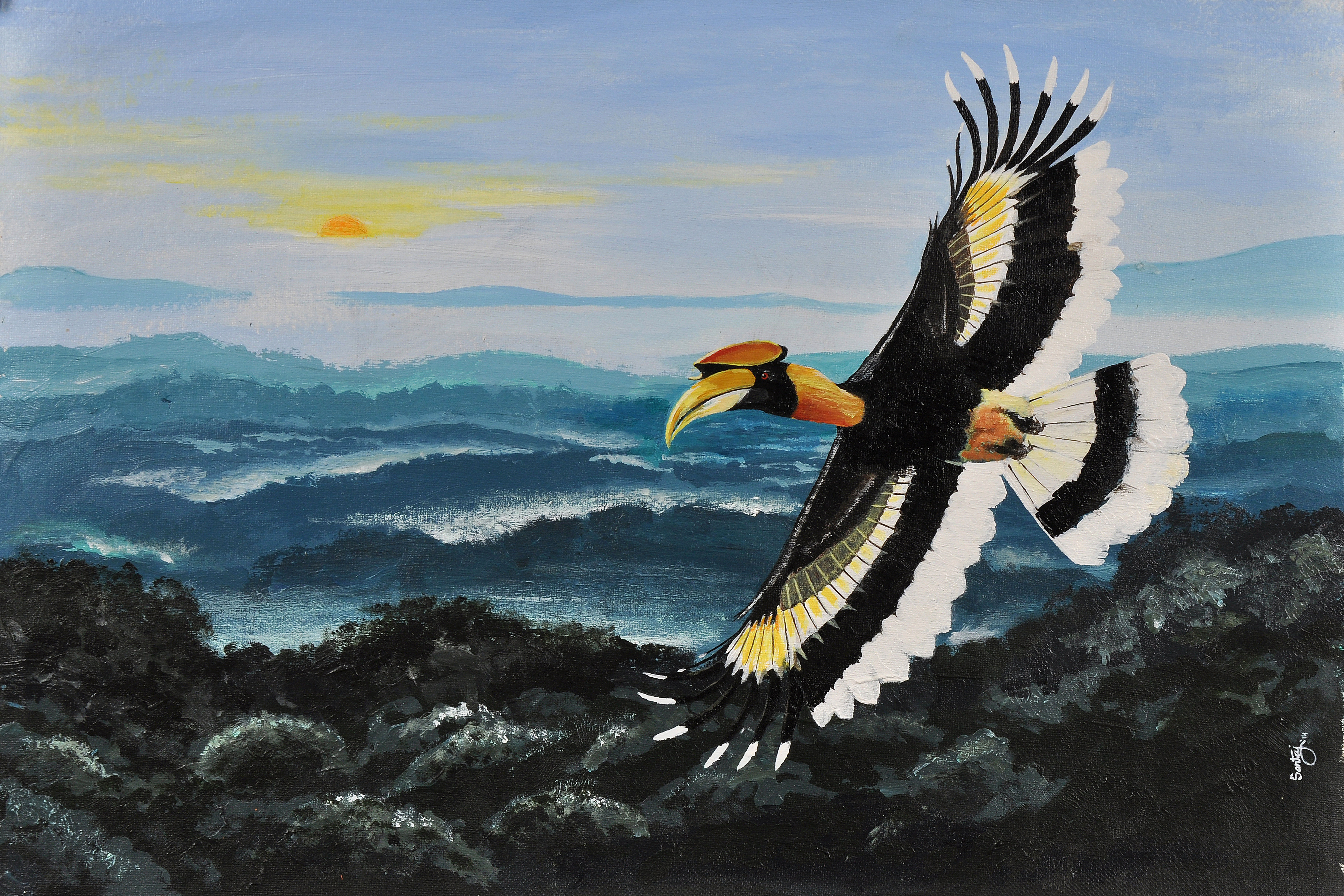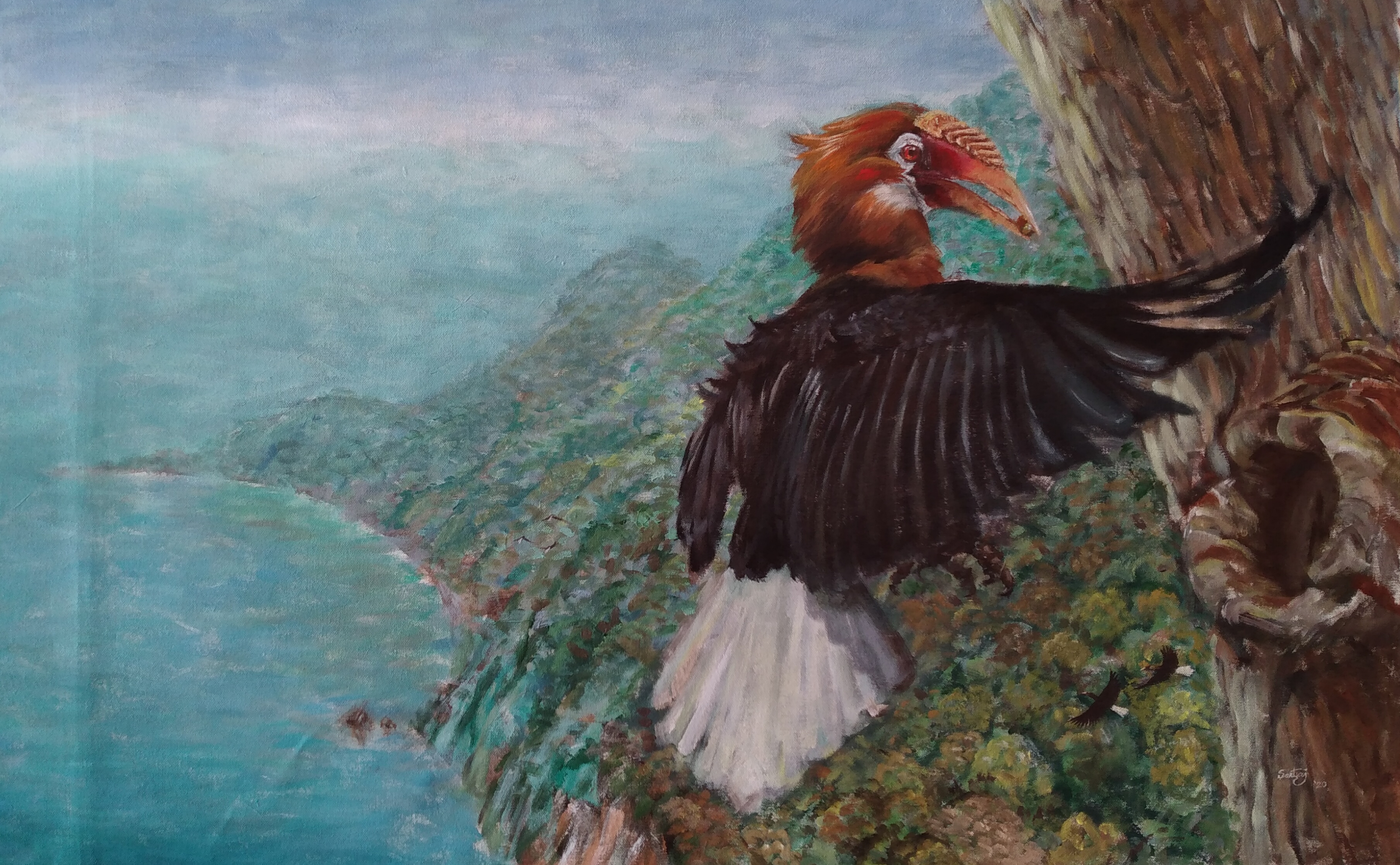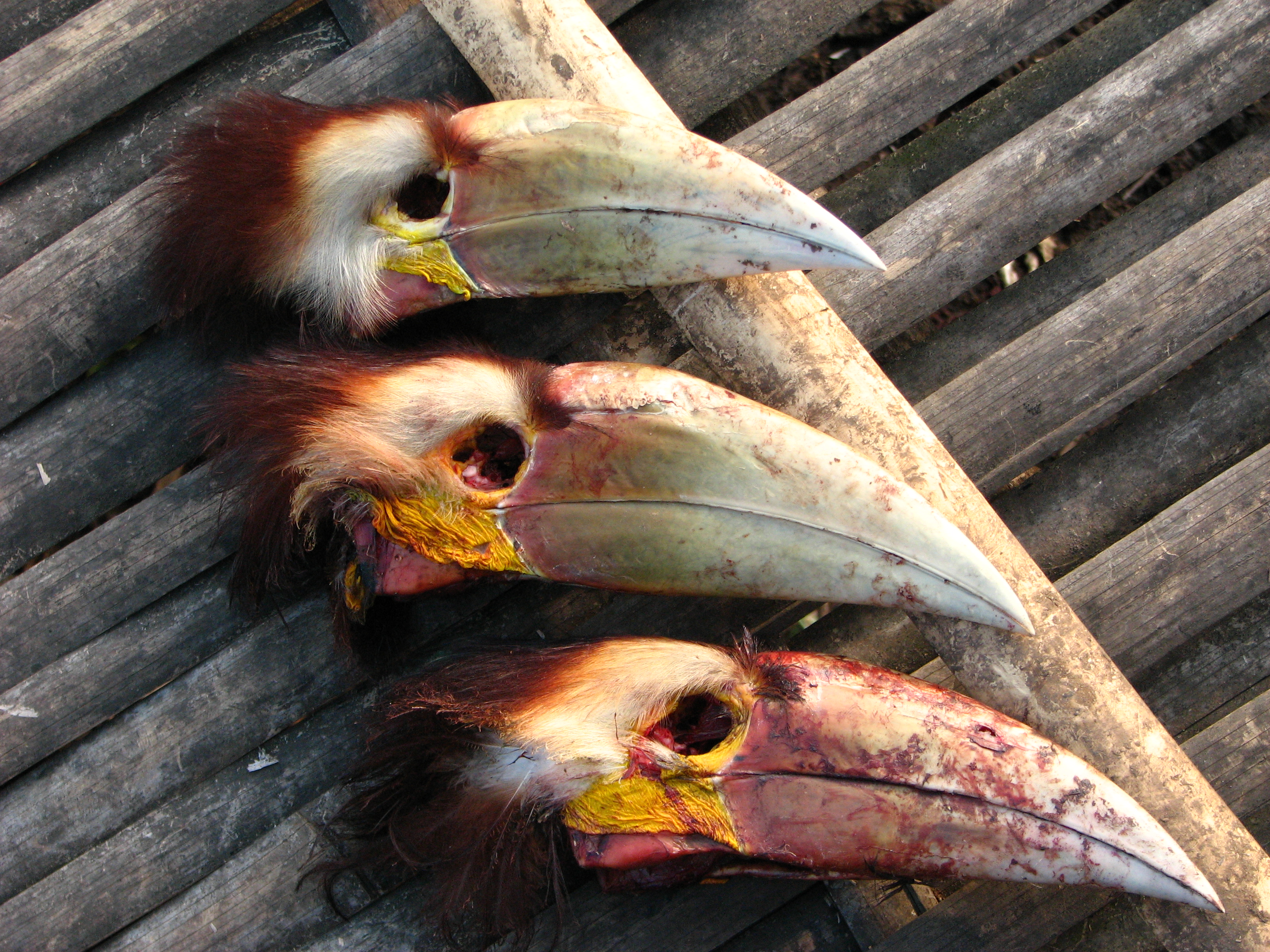The Freewheeling Hornbills
First published in Sanctuary Asia,
Vol. 40
No. 10,
October 2020
By Rohit Naniwadekar and Sartaj Ghuman
If you put in a good day’s climb in one of Northeast India’s Protected Areas, hiking up from the river bed till you get to a good vantage point, you should be able to see the mountain ridges, covered in broccoli-canopied forests, receding wave upon wave until they seem to – depending on which way you’re looking – either merge with the horizon or come up against snow-clad peaks. A hornbill would know this landscape like the back of its foot, right down to the seasonality of every fruiting tree, down to every cavity in the emergents rising above the canopy. Like the old hunters of lore, for instance, or like elephant matriarchs perhaps. Except that hornbills are actually the force that holds this landscape together.
Gardeners of the Forest
Amongst the largest fruit-eating birds of the tropical forests of Asia, hornbills are often referred to as ‘Farmers of the Forest’. By swallowing whole fruits and then broadcasting the seeds as they soar above the canopy, hornbills play a crucial role in maintaining the vibrant diversity of tropical forests.
Undispersed seeds that accumulate in large numbers under the parent trees face multiple threats from pathogens, insects, rodents and other seed predators. Even if the seeds manage to escape predation and germinate under the parent tree, they still have to compete with numerous siblings for resources and then there’s the threat rom herbivores, who are attracted to the clump of saplings crowded together. Birds like the hornbills are perfectly adapted to help the seeds escape these dangers in a mutualistic interaction wherein both hornbills and plants benefit. In return for the nutritious pulp that the seeds are embedded in, the hornbills scatter the undamaged seeds far and wide, ensuring healthy regeneration for the trees.

‘Farmers of the forest’, the fruit-loving Rufous-necked Hornbills Aceros nipalensis are a keystone species that can disperse an estimated 12,000 large seeds per square kilometre, every single day. Several large-seeded plants are dependent exclusively on hornbills for their dispersal. Photo: Sarbajit Ghosh
But first, the hornbills must be able to locate a fruiting tree. These are patchily distributed in a tropical forest and the availability of fruits within these patches changes over time. Our research has found that different hornbill species that co-occur – all predominantly fruit-eaters - often use different strategies to track the various fruits that they prefer over space and time.
As part of our research, we put GPS tags on Great and Wreathed Hornbills in the Pakke Tiger Reserve, Arunachal Pradesh, in Northeast India. We tagged a Wreathed and a Great Hornbill within days of each other. Their nests were separated by only a few hundred metres and they had access to similar fruit resources. Yet the Wreathed Hornbill ranged over an area of 55 sq. km. while the Great Hornbill ranged over only two square kilometres.
This is probably a consequence of the dietary choices of the two species – while the Great Hornbill prefers figs, the Wreathed Hornbill prefers non-fig fruits. The ranging patterns also translate into differences in how far the two birds disperse seeds from the parent plant. On average, while the Great Hornbill dispersed seeds about 250 m. away from the parent trees, the Wreathed Hornbill cast seeds more than a kilometre away from the parent trees.
Both birds also regularly visited the degraded Reserved Forests outside Pakke Tiger Reserve, thereby indicating how hornbills could aid natural regeneration of such forests. We have estimated that in areas with very high densities of hornbills, they could be dispersing up to 12,000 seeds per day per square kilometre. Since small fruit-eating birds cannot swallow large seeds, several of these large-seeded plants are dependent exclusively on hornbills for their dispersal. The numbers of small seeds that hornbills disperse would, of course, be several orders higher.

A painted depiction of the Great Hornbill Buceros bicornis (also banner image above) showing the impressive wingspan (about 152 cm.) of the largest hornbill species of the Indian subcontinent. They can be found in the old-growth unlogged forests of the Western Ghats and in the forests along the Himalaya, which are now increasingly fragmented. Photo: Sartaj Ghuman.
Spread Them Far and Wide
In this day and age, with forests facing unprecedented levels of fragmentation and the unmitigated wrath of climate change, long-distance dispersal can be a boon. It can ensure genetic connectivity between fragmented tree populations and also enable plants to move to suitable habitats with the changing climate. Hornbills can perform the critical function of long-distance seed dispersal, which not many other animals can.
In Northeast India, for instance, Wreathed Hornbills breed in the lowland forests from March to July. During the winter, low fruit availability in the lowland forests forces them to venture out in search of food. Incidentally, it is also the time when fruit availability in the mid-elevation forests peaks and so Wreathed Hornbills migrate up to the mid-elevation forests (400 – 2,000 m.) of Namdapha Tiger Reserve in large numbers.
While other birds move to lower elevations in winter, Wreathed Hornbills move up in search of some favoured fruits such as Canarium and Phoebe. Great and Rufous-necked Hornbills, on the other hand, track their preferred fruits locally and do not migrate seasonally in and out of Namdapha. Not only does this make the different hornbills important seed dispersers for different fruiting trees, it also likely reduces inter-specific competition permitting them to share the same habitat without conflict.
Ranging over large distances in search of patchily distributed fruit resources can have evolutionary implications for the birds as well. Most of their close relatives, like the Wreathed Hornbill, travel over great distances – the most famous being the Plain-pouched Hornbills that-migrate in large numbers from Thailand to Malaysia each year. Another relative of the Wreathed Hornbills is the Narcondam Hornbill, restricted to the 6.8 sq. km. Narcondam Island in the Andaman Sea. Its global population is approximately 1,000 birds! One can imagine a flock of the Narcondam Hornbill ancestors to have taken off from mainland Myanmar in search of fruits and having landed on the island. We do not yet know whether there were multiple waves of ancestors or a single flock that arrived on Narcondam to evolve into a different species. To add to the perplexity, the closest extant relative of the Narcondam Hornbill today is the Papuan Hornbill, found in distant Papua New Guinea and its adjoining islands at the edge of the Pacific Ocean. These hornbills historically ranged over large parts of the archipelagos of Southeast Asia that were geologically in flux and have thus left us with numerous such ecological and evolutionary puzzles that we are yet to solve.

A painting of the endemic Narcondam Hornbill Rhyticeros narcondami, restricted to the 6.8 sq. km. Narcondam Island in the Andamans. Photo: Sartaj Ghuman.
Humans vs. Hornbills
What we are almost certain of, however, is that hornbills evolved in the mid-Eocene (around 50 million years ago) in the African savanna - the very place where, 47 million years later, early hominids evolved. Our paths seem to have not crossed for a while, but that encounter, when it came, was an unfortunate one for hornbills. Hornbill remains found in caves in Vietnam and Borneo dating back to 24,000 years are a testimony to their persecution at human hands.
Given the way humans now treat the planet, hornbill persistence is even more precarious. Their habitats are being lost at an alarming rate and they are going locally extinct from multiple sites. Extensive Protected Areas like the Namdapha Tiger Reserve (spread over an area of 1,985 sq. km.), which attract large numbers of Wreathed Hornbills are few, and even they cannot guarantee the persistence of this far-ranging species. These magnificent birds leave Namdapha to breed in the adjoining non-Protected Areas of India and in Myanmar, where they are vulnerable to hunting and other anthropogenic threats.
As humans plough on in the pursuit of the ambiguous utopia of a developed world, we will continue to trample these evolutionary enigmas under our ever-expanding footprints. What we’re also wrecking in the process is the quality of human existence. It is therefore essential that we find alternative models of development that explicitly look upon nature conservation as an integral and elemental measure of human development. For not only do these marvels of the natural world make life worth living, they are what make life possible.

Slow breeders, hornbills are particularly vulnerable to anthropogenic pressures. Hunting by indigenous communities, who use the beaks and casques for traditional charms and headgear, also poses a threat. However, some NGOs have successfully encouraged the use of fibreglass replicas to stem hunting and have initiated programmes to benefit communities who protect the species. Photo: Rohit Naniwadekar.
Rohit Naniwadekar is a Scientist at the Nature Conservation Foundation and is fascinated by hornbills and tropical forests. Sartaj Ghuman, a wildlife biologist and a painter, is currently trying his hand at farming.





